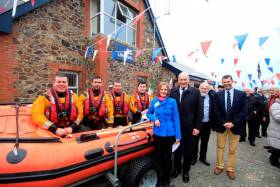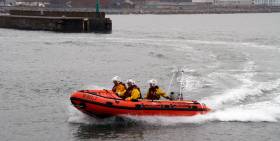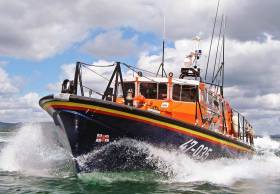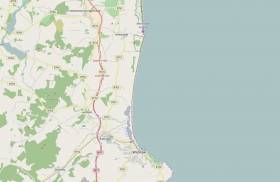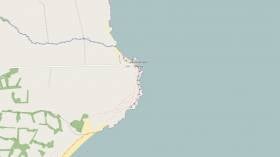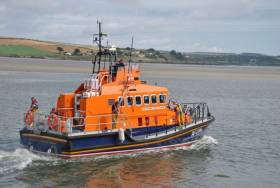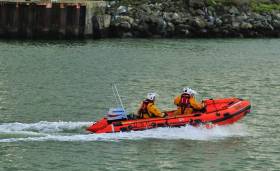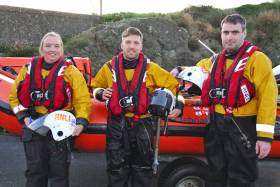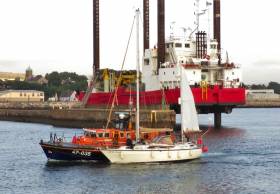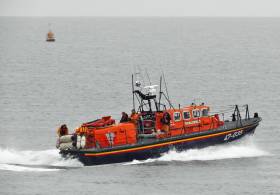Displaying items by tag: Wicklow
Wicklow D Class Lifeboat Named After Late Couple’s Dream to Fund a Lifeboat is Fulfilled
At a special ceremony held yesterday (Saturday 6 May), Wicklow RNLI officially named its new D class lifeboat, Dennis-Audrey.
David Delamer, chair of the RNLI Council in Ireland, accepted the lifeboat on behalf of the RNLI before handing her over into the care of Wicklow Lifeboat Station.
The funding for the new lifeboat came from Gladys Audrey Deakin, known as Audrey, who lived in Coventry, and left her residuary estate to the RNLI.
Audrey and her late husband Dennis loved holidays by the sea and were impressed by the work of the charity’s volunteers. It was their dream that their bequest be used to fund a lifeboat and that it would be named after them.
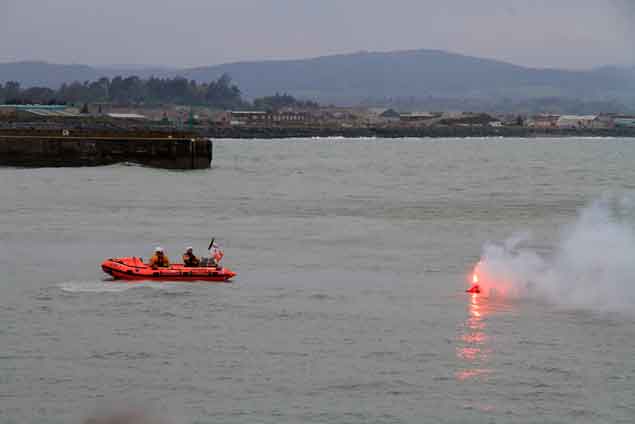 Wicklow RNLI performs a simulated exercise on the new lifeboat for well-wishers at the end of the naming ceremony and service of dedication for the D class Dennis-Audrey.
Wicklow RNLI performs a simulated exercise on the new lifeboat for well-wishers at the end of the naming ceremony and service of dedication for the D class Dennis-Audrey.
The couple were represented at the ceremony by Audrey’s solicitor Michelle Gavin who handed the lifeboat to the RNLI.
In his address, Mr Delamer said that one may be forgiven for thinking that we knew little about Audrey as Michelle’s relationship with her began posthumously as executor of her will.
‘But,’ he continued, ‘we know a great deal about her through one simple action; she has provided us with this life-saving vessel. That vessel has found a home here in Wicklow and will go on to save many lives and bring countless loved ones home. That one fact says a great deal indeed about Audrey and we will remember her for her generosity and her humanitarianism for many years to come.’
Phylis Whyte, former chair of the Wicklow RNLI fundraising branch had the honour of officially naming the lifeboat during the ceremony.
Des Davitt, Wicklow RNLI Lifeboat Operations Manager said the naming ceremony and service of dedication was a wonderful occasion in the history of the lifeboat station, and paid tribute to the generosity of Dennis and Audrey Deakin.
Speaking following the ceremony he said: ‘This new craft which will be housed and work alongside our all-weather lifeboat, gives our volunteer crew the power, equipment and rescue platform they need to keep those who use the sea safe.
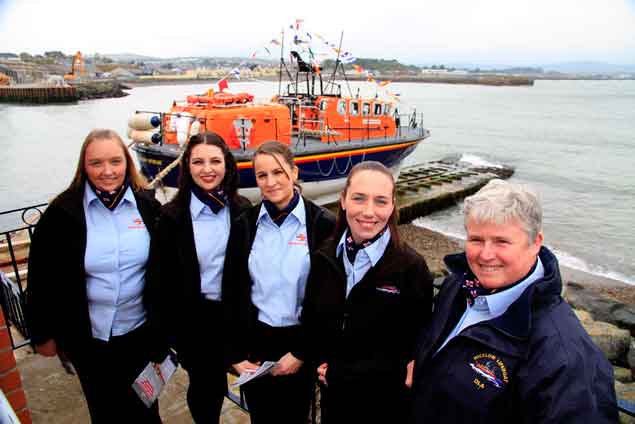 Wicklow RNLI female crew members Carol Flahive, Amy O’Neill, Brid Seoighe, Lisa O’Leary and Deputy Launching Authority Mary Aldridge.
Wicklow RNLI female crew members Carol Flahive, Amy O’Neill, Brid Seoighe, Lisa O’Leary and Deputy Launching Authority Mary Aldridge.
‘Every rescue is powered by our generous supporters, people like Dennis and Audrey. Their kind and selfless gift will help ensure we in Wicklow are ready for the next call, wherever and whenever it comes. For that, the RNLI and everyone at Wicklow lifeboat station will be forever grateful to them.
Mr Davitt paid tribute to the volunteers at Wicklow RNLI saying it was they who would give the new boat life: ‘Their commitment and ongoing attendance for training means that they are highly proficient in the operation of both our lifeboats. Further testament of the dedication of the crew is their knowledge that they may risk their own lives in the service of others. There is nothing greater that a person could offer and they deserve nothing less than the best lifeboat, equipment and training that money can buy.’
He thanked the local fundraising branch too, for their untiring work and praised the generosity of the people of Wicklow and further afield for helping to raise funds to enable the station to continue to save lives at sea.
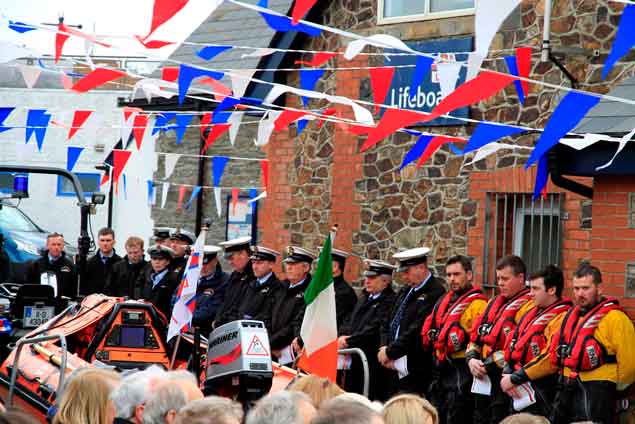 Wicklow RNLI lifeboat crew pictured alongside their new D class lifeboat Dennis-Audrey during the naming ceremony and service of dedication at Wicklow lifeboat station.
Wicklow RNLI lifeboat crew pictured alongside their new D class lifeboat Dennis-Audrey during the naming ceremony and service of dedication at Wicklow lifeboat station.
He added that while this was a time for celebration it was also a time to acknowledge the risks taken by all emergency service personnel in the service of others. A minutes silence was observed at the start of the ceremony in remembrance of five brave members of the Irish Coast Guard who lost their lives in the past year, Catriona Lucas, Dara Fitzpatrick, Mark Duffy, Ciaran Smith and Paul Ormsby.
Last year, Wicklow RNLI which also has an all-weather lifeboat launched 37 times and rescued 38 people. The all-weather Tyne class lifeboat Annie Blaker launched 21 times bringing 28 people to safety while the inshore lifeboat launched 16 times bringing 10 people to safety.
The new inshore lifeboat is replacing the Sheringham Shantymen, which was on service for 10 years at Wicklow RNLI. The lifeboat which was named after the Sheringham Shantymen was funded by money raised at their concerts. During its time in Wicklow, the lifeboat rescued 96 people, seven dogs and a farmer’s sheep.
First introduced into the RNLI fleet in 1963, the design of the inflatable D class lifeboat continues to evolve to meet changes in demand and technology.
It is the workhorse of the RNLI’s fleet and is ideal for working close inshore, near rocks or in shallow water in moderate conditions. It can be righted by the crew if it capsizes and is also part of the RNLI Flood Rescue Teams fleet of boats.
A highly manoeuvrable lifeboat, the D class can operate closer to shore than Wicklow’s all-weather lifeboat and comes into her own for searches and rescues in the surf, shallow water and confined locations - often close to cliffs, among rocks and even inside caves.
A lifeboat station was established in Wicklow in 1857. The first lifeboat was a 30ft rowing boat.
In 1911 the boathouse was adapted and the station’s first motor lifeboat, the first for Ireland, arrived.
In 1989, the boathouse was adapted once again and the slipway extended for the station's new Tyne class lifeboat. The adaptation to the boathouse included improved crew facilities and additional extensions for the refurbished winch and a souvenir sales outlet. The slipway was extended by 24 metres.
A D class lifeboat first went on service in Wicklow in 1995 with a new boathouse extension for housing the lifeboat completed in 1997.
A crowd of well-wishers turned up to see the lifeboat officially named with a bottle of champagne poured over the side of the boat by Phylis Whyte. Following the ceremony the crowd gathered around the harbour wall to see the lifeboat launch and watch as helm Alan Goucher, Connie O’Gara, Dean Mulvihill and Paul Sillery performed a simulated exercise.
Among the guests officiating at the ceremony were Judge Gerard Haughton, chair of the Lifeboat Management Group who welcomed guests and opened proceedings; Michelle Gavin, representative of the donor, who handed the lifeboat over to the RNLI, David Delamer, chair of the RNLI Council for Ireland, who accepted the lifeboat on behalf of the RNLI and handed her into the care of the lifeboat station and Des Davitt, Wicklow RNLI Lifeboat Operations Manager, who accepted the lifeboat on behalf of the station. A vote of thanks at the end was read out by Jill Clancy-Harold, Wicklow RNLI fundraising chair.
Father Donal Roche, parish priest, and Reverends Ken Ru and Jack Kinkead, led the Service of Dedication.
Sean Olohan and the Wicklow Swim for Life choir led the congregation in song
Wicklow RNLI to Name New Inshore Lifeboat
A new inshore lifeboat for Wicklow RNLI is to be officially named Dennis-Audrey during a ceremony at the lifeboat station at 4pm this Saturday 6 May.
The lifeboat which went on service in February this year was funded by Gladys Audrey Deakin who left her residuary estate to the RNLI for the funding of a lifeboat.
Audrey and her late husband Dennis loved holidays by the sea and were impressed by the work of the RNLI. It was their dream that their bequest be used to fund a lifeboat and that it would be named after them.
The donor will be represented by Audrey’s solicitor Michelle Gavin at the naming ceremony and service of dedication and she will officially hand the lifeboat into the care of the RNLI.
The honour of naming the lifeboat will go to Phylis Whyte, a former chair of the Wicklow RNLI fundraising branch.
Last year, Wicklow RNLI which also has an all-weather lifeboat launched 36 times and rescued 36 people. The all-weather Tyne class lifeboat Annie Blaker launched 21 times bringing 26 people to safety while the inshore lifeboat launched 15 times bringing 10 people to safety.
The new inshore lifeboat is replacing the Sheringham Shantymen, which was on service for 10 years at Wicklow RNLI. The lifeboat which was named after the Sheringham Shantymen was funded by money raised at their concerts. During its time in Wicklow, the lifeboat rescued 96 people, seven dogs and a farmer’s sheep.
Speaking ahead of Saturday’s naming ceremony, Des Davitt, Wicklow RNLI Lifeboat Operations Manager said: ‘The naming ceremony and service of dedication is a special occasion for our lifeboat station and we are grateful to Audrey and Dennis who generously funded our new lifeboat.’
First introduced into the RNLI fleet in 1963, the design of the inflatable D class lifeboat continues to evolve to meet changes in demand and technology.
It is the workhorse of the RNLI’s fleet and is ideal for working close inshore, near rocks or in shallow water in moderate conditions. It can be righted by the crew if it capsizes and is also part of the RNLI Flood Rescue Teams fleet of boats.
A highly manoeuvrable lifeboat, the D class can operate closer to shore than Wicklow’s all-weather lifeboat and comes into her own for searches and rescues in the surf, shallow water and confined locations - often close to cliffs, among rocks and even inside caves.
A lifeboat station was established in Wicklow in 1857. The first lifeboat was a 30ft rowing boat.
In 1911 the boathouse was adapted and the station’s first motor lifeboat, the first for Ireland, arrived.
In 1989, the boathouse was adapted once again and the slipway extended for the station's new Tyne class lifeboat. The adaptation to the boathouse included improved crew facilities and additional extensions for the refurbished winch and a souvenir sales outlet. The slipway was extended by 24 metres.
A D class lifeboat first went on service in Wicklow in 1995 with a new boathouse extension for housing the lifeboat completed in 1997.
The RNLI is a charity which relies on voluntary contributions and legacies.
Wicklow Lifeboat Assists Fisherman Adrift Near Kiloughter Beach
#RNLI - Wicklow RNLI's all-weather lifeboat launched at 10.52am yesterday morning (Saturday 29 April) to search the bay for a missing fisherman.
The lifeboat, under the command of coxswain Nick Keogh with a volunteer crew, proceeded north to the fisherman’s last known position.
Weather conditions in the area at the time were described as moderate seas with a south-easterly Force 4 wind.
Twelve minutes after launching, the lifeboat crew located the man in his small boat near Kiloughter beach, in what Keogh described as “choppy” seas.
A quick assessment found he was unable to get back to Wicklow Harbour due to mechanical problems with the outboard engine.
The boat was taken in tow back to the garbour, where the fisherman was landed safely ashore just before midday.
“We were happy to assist him,” Keogh added.
Emergency Repairs On East Coast Rail Line After Storm Angus Erosion
#CoastalNotes - Coastal defences in Wicklow suffered significant damage during last week’s Storm Angus, posing a renewed threat to the East Coast rail line, as The Irish Times reports.
The Irish Sea came within metres of the busy Dublin-Wexford line in parts between Newcastle and Wicklow town after erosion from high tides powered by Force 10 winds in the first winter storm of the 2016-17 season.
The same extreme conditions saw a Stena Line ferry stranded outside Fishguard, unable to dock in the Welsh port for more than 24 hours after sailing from Rosslare last Tuesday morning (22 November).
Damage is said to be most severe in Co Wicklow close to where extensive repairs were carried out this past January, with rock armour placed on the adjacent beach at the Murrough, a Natura 2000-designated wetland that’s the largest of its kind on the East Coast.
Further rock armour and steel piling is now being placed at Greystones going south to Kilcoole to protect that stretch of the line after the storm displaced a significant amount of sand, as Iarnród Éireann declared “emergency intervention was required immediately” to save the rail line from future incursion by the sea.
The Irish Times has more on the story HERE.
Search Resumes For Missing Fisherman Off Wicklow-Wexford Border
#Missing - The search was set to resume this morning for a fisherman missing after going overboard from a three-man fishing vessel off the Wicklow-Wexford border yesterday morning (Wednesday 16 November).
As The Irish Times reports, RNLI lifeboats from Rosslare and Wicklow were tasked along with the Waterford-based Irish Coast Guard helicopter Rescue 117 and later Rescue 116 from Dublin Airport to the incident some 6km east of Kilmichael Point in Co Wexford.
It's understood that the missing man is in his late 40s or eary 50s, according to BreakingNews.ie.
Wicklow, Courmacsherry Lifeboats Rescue Fishing Boats In Difficulty
#RNLI - RNLI lifeboats from Wicklow and Courtmacsherry have responded to two separate calls from fishing boats in difficulty around the Irish coast in recent days.
A trawler with three fishermen onboard was towed to safety by Wicklow RNLI yesterday morning (Thursday 10 November) after it lost all power 10 miles offshore.
The all-weather lifeboat, under the command of coxswain Nick Keogh and a volunteer crew, launched shortly after 10am and were alongside the stricken fishing vessel 40 minutes later.
The skipper had dropped an anchor, but it had dragged and the vessel had drifted a short distance south with the tide. Conditions in the area had a slight sea state, with northwesterly winds of Force 2-3 and good visibility.
The Naval Service patrol vessel LÉ Orla and the work vessel Wildcat 2 also stood by the trawler as the lifeboat crew established a towline.
The trawler, with three crew on board, was then towed back to Wicklow and brought safely alongside the South Quay at 12.15pm.
The previous evening (Wednesday 9 November), Courtmacsherry RNLI's all-weather lifeboat was called out at 10.15pm to aid a 65ft fishing vessel in difficulty 25 miles south of the Old Head of Kinsale in West Cork.
The lifeboat, under coxswain Sean O'Farrell and a crew of six, launched immediately and located the casualty at 11.25pm. Conditions at sea were reasonable, with winds in the area blowing 26 knots.
The fishing boat, with three people on board had encountered trouble with its power while trawling in the area and required assistance.
On scene, the lifeboat quickly assessed the difficulties and for the next two hours, the lifeboat and stricken vessel proceeded back at low speed to Kinsale, where the boat was safely berthed at 1.45am.
The crew on board Wednesday night’s callout with O'Farrell were mechanic Stewart Russell, Ken Cashman, Donal Young, Ciaran Hurley, Denis Murphy and Conor Tyndall.
Wicklow Lifeboat Assists Drifting Jet Skier
#RNLI - Wicklow RNLI's inshore lifeboat launched shortly after 5pm yesterday evening (Sunday 25 September) to assist a person on a broken-down personal water craft.
The man had set off from Wicklow Harbour and was about a mile offshore when the engine cut out, leaving him adrift and unable to get ashore.
The lifeboat was alongside the casualty within minutes of launching and the crew carried out a quick assessment before towing the craft back into Wicklow Harbour and landing the man safely ashore.
Wicklow Lifeboat Volunteers Assist Lone Sailor & Rescue Man From Water In Weekend Callouts
#RNLI - Lifeboat volunteers with Wicklow RNLI responded to two callouts over the weekend, assisting a lone yachtsman and a person in the water.
The first came on Saturday 17 September as the all-weather lifeboat Annie Blaker launched at 2.55pm to assist a small yacht south of Wicklow harbour.
The vessel, with one person on board, had developed mechanical problems near the horseshoe buoy. With light winds, he was unable make his way back to Wicklow Harbour.
English yacht Amica, which was passing, made contact and attempted to tow the vessel back to Wicklow. However, with the tide against him and strong currents, they were unable to make much headway around Wicklow Head.
The lifeboat, under the command of coxswain Nick Keogh, located the vessel off Wicklow Head and a towline was quickly established. The yacht and the lone sailor were brought safely alongside the East Pier shortly after 3.45pm.
The second callout came yesterday morning (Sunday 18 September) at 6:45am after the Irish Coast Guard received a report of a person in the water at Wicklow Harbour. The inshore lifeboat crew arrived on scene at the South Quay a short time later.
Lifeboat volunteer Ian Thompson entered the water to rescue the casualty, who was disorientated and injured.
Thompson was able to assess and reassure the casualty before bringing him to a nearby ladder and, with the assistance of gardaí, the person was lifted to safety and transferred to a waiting ambulance for medical treatment.
This multi-agency rescue operation involved the the coastguard, Wicklow RNLI, Wicklow Garda and the Wicklow Ambulance Service.
Elsewhere, the body of a man was recovered from the River Lee in Cork city last night hours after a car was reportedly seen entering the water at Kennedy Quay. BreakingNews.ie has more on the story HERE.
Wicklow Lifeboat Assists Yacht In Early Morning Callout
#RNLI - Wicklow RNLI's all-weather lifeboat launched at 5.32am yesterday morning (Wednesday 7 September) after the Irish Coast Guard received a call for assistance from a yacht in difficulties off the Wicklow coast.
The 10m British ketch, with two people on board, was on passage from Cornwall to Scotland when it developed steering problems, and its crew were having difficulty maintaining their course.
The lifeboat crew located the vessel in fog eight miles east of Wicklow Harbour at 6.10am. Conditions in the area had a southwest Force 3 with moderate sea and poor visibility.
The yacht was taken in tow back to Wicklow Harbour and was secured safely alongside the south quay at 7.45am.
Wicklow Lifeboat Assists Whelk Trawler In Morning Callout
#RNLI - Wicklow's all-weather lifeboat Annie Blaker launched at 7.30am yesterday morning (Saturday 3 September) to assist a fishing vessel four miles offshore.
The RNLI lifeboat, under the command of coxswain Nick Keogh, was alongside the stricken vessel 18 minutes after launching.
After a quick assessment, the 12m whelk trawler with three crew was found to have gearbox failure and unable to motor back to port.
Weather conditions in the area at the time saw a sea state slight with rain and fair visibility.
Once a towline was established, the trawler was taken back to Wicklow Harbour, where the volunteer crew secured the fishing vessel safely alongside the south quay by 8.40am.


























